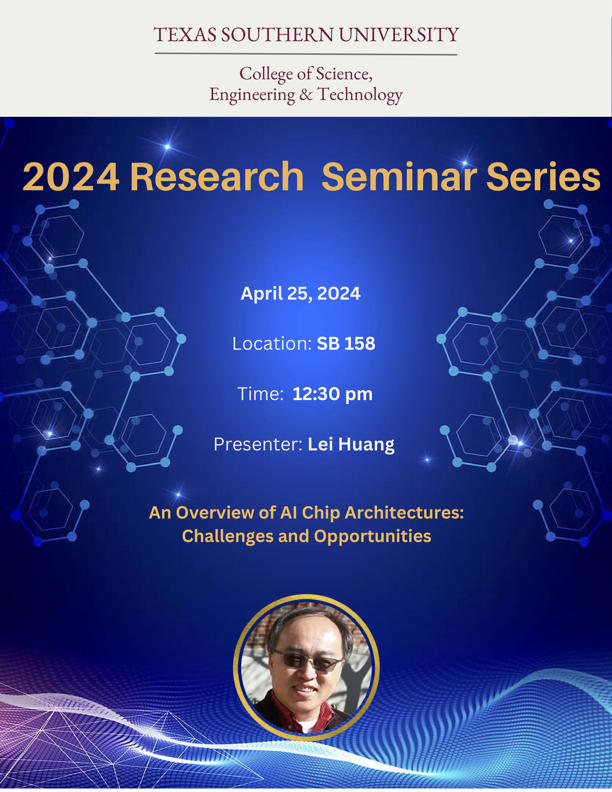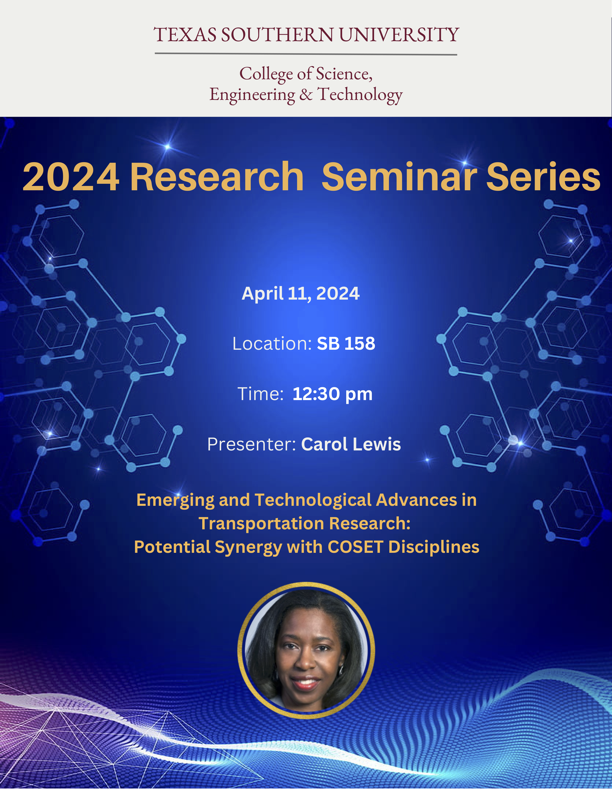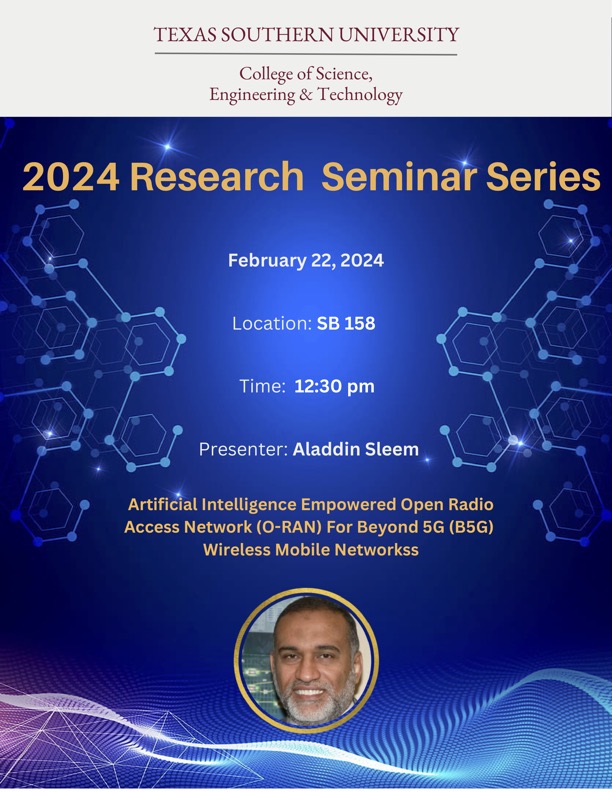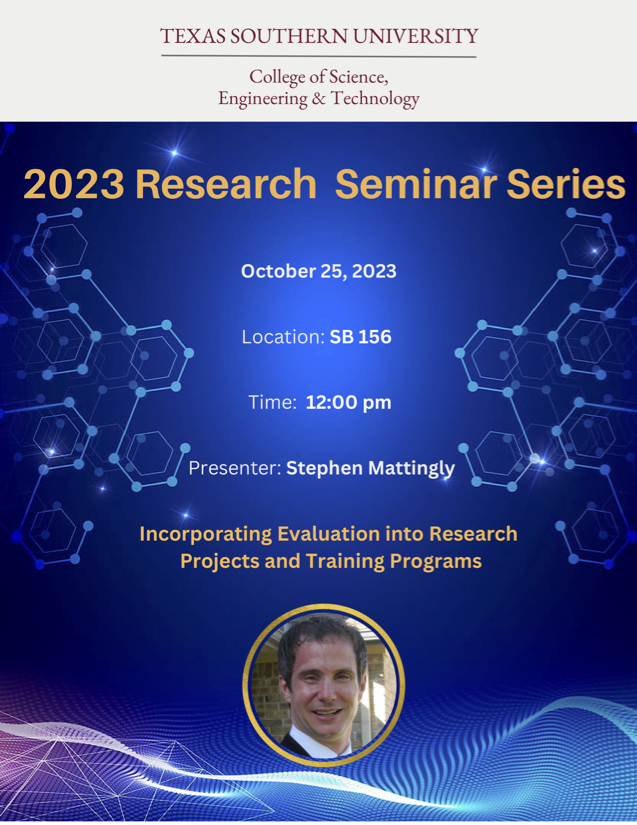or keep pressing Tab key no navigate
April 25, 2024
Location: SB 158
Time: 12:30 pm
Presenter: Lei Huang
An Overview of AI Chip Architectures: Challenges and Opportunities
Abstract:
In the modern landscape, artificial intelligence (AI) pervades our daily lives, powering virtual assistants, autonomous vehicles, and more. Yet, the underlying technology driving these innovations, AI chip architecture, remains a topic often covered in complexity. This presentation seeks to demystify AI chip architecture, offering an accessible walkthrough suitable for both beginners and professionals.
Beginning with foundational concepts, I will introduce the core principles that distinguish AI chips from traditional computing architectures, using relatable examples to illustrate their practical applications. We will then delve into the current state-of-the-art AI chip designs, including Nvidia’s high-performance GPUs, Google’s specialized TPUs, and recent advancements from industry leaders such as AMD, Intel, and other promising startups. Furthermore, we will explore emerging architectures like neuromorphic and photonic chips, discussing their potential to redefine the future of AI hardware.
Throughout the presentation, I will navigate the interdisciplinary nature of AI chip design, highlighting its intersection with fields such as computer science, electrical engineering, and mathematics. By clarifying technical terminology and demonstrating design principles, I aim to provide attendees with a comprehensive understanding of AI chip architecture, its software ecosystem, and its implications for the broader technological landscape.
Lastly, for students aspiring to enter the AI industry, I will offer advice to better prepare themselves for the exciting and collaborative nature of AI research and development in industry settings.
Lei Huang, Ph.D., is a senior technical staff member at Lightmatter, a spin-off from MIT dedicated to developing the next generation of photonic AI chips. With a background in AI, high-performance computing (HPC), and compiler technology, Dr. Huang brings extensive research experience to his current role.
Previously, Dr. Huang served as an Associate Professor in the Department of Computer Science at Prairie View A&M University (PVAMU), where he led research efforts at the Computing Research Lab. During his tenure, he also held the position of Associate Director of Research at the Center of Excellence in Research and Education for Big Military Data Intelligence, sponsored by the Department of Defense (DoD). Dr. Huang earned his Ph.D. from the Computer Science Department at the University of Houston in 2006.

Light lunch will be served.
April 11, 2024
Location: SB 158
Time: 12:30 pm
Presenter: Carol Lewis
Emerging and Technological Advances in Transportation Research: Potential Synergy with COSET Disciplines
Abstract:
Rapid advances in transportation technology, such as self-driving cars and other, present unique and unprecedented research opportunities for with most academic fields, especially in Science, Technology, Engineering and Mathematics (STEM). I will discuss several ways to enhance collaborations in COSET.
Lewis, Ph.D., educates students in fundamentals of transportation and urban transportation issues, as well as conducts operational and policy related transportation research. Prior to joining Texas Southern University in 1992, Lewis spent 15 years as manager and director of planning at the Metropolitan Transit Authority of Harris County (METRO). Lewis serves as an appointee of Houston Mayor Sylvester Turner and County Judge Lina Hidalgo and Harris County Commissioner’s Court to Chair the Gulf Coast Rail District. Through this appointment, Lewis is a member of the Houston Galveston Area Council’s Transportation Policy Council since 2018. Lewis is also a member of the Transportation Research Board’s Executive Council. She served as a METRO Board Member from 2002 to early 2004 and as Executive Assistant to Mayor Bill White for Transportation Planning 2005 to 2009. Lewis holds a Master’s degree in planning and the Ph.D. in Political Science with an emphasis in Public Policy and Public Administration.

Light lunch will be served.
February 22, 2024
Location: SB 158
Time: 12:30 pm
Presenter: Aladdin Sleem
Artificial Intelligence Empowered Open Radio
Access Network (O-RAN) For Beyond 5G (B5G) Wireless Mobile Networks
Abstract:
Since its first deployment decades ago, mobile phone networks have been architected based on vendor-specific solutions for the Radio Access Network (RAN) and other components of the network. This limited the ability of mobile service providers to integrate different segments of their deployed mobile network unless they were all made by the same vendor.
Recently, the Open Access Radio Network (O-RAN) initiative was launched aiming at moving away from the single-vendor model for the entire RAN solution. It breaks down the radio access network into functional components and specifies set of standards that equipment suppliers should follow to produce mobile network devices that are non-proprietary and can be integrated with devices from other vendors. The RAN Intelligent Controller (RIC), which is a component of the O-RAN architecture, is a software component that controls and optimizes the functions of the radio access network. The RIC enables the integration of third-party applications that can lead to improving customer quality experience while lowering the operating cost of mobile operators.
Machine learning (ML) techniques, particularly Deep Learning (DL), have been gaining considerable attention in managing and optimizing the operations of various O-RAN components including its RAN Intelligent Controller (RIC). Deep learning models can learn from historical data and use this knowledge to predict network events such as service interruption or quality of service degradation. This gives the service provider the opportunity to be proactive in minimizing the impact of these events on network users. Additionally, near-real time network optimization tasks, such as dynamic spectrum allocation, can also be adjusted based on real-time network conditions using trained DL models.
This presentation will provide an overview of the O-RAN architecture and its benefits. Additionally, it will highlight the fundamentals of Deep Learning models and how they can be integrated into the O-RAN architecture to make future wireless networks smarter and more efficient.
Aladdin M. Sleem, Ph. D. is an Associate Professor of Computer Science in the College of Science Engineering and Technology. He is an expert in internet protocols and multimedia networking. He served as interim Chair for the Department of Engineering, interim Dean for the College of Science, Engineering and Technology and interim Associate Provost and Associate Vice President for Academic Affairs at Texas Southern University.

Light lunch will be served.
October 25, 2023
Location: SB 156
Time: 12:00 pm
Presenter: Stephen Mattingly
Incorporating Evaluation into Research Projects and Training Programs
Abstract:
Many funders such as the National Science Foundation and National Institutes of Health require either internal and/or external evaluation of research projects or training programs to improve the processes and outcomes of the funded activities. Principal investigators on such projects must include evaluation plans and budgets in their proposals, collaborate with evaluation teams to ensure quality evaluations for the funded project, and include evaluation reports in their periodic reports to the funder. Principal investigators may also choose to conduct evaluations of their projects even when they are not required by funders for continual quality assurance and improvement.
This presentation discusses program evaluation from grant application to project closeout for research and training grants. It explains what to expect from an evaluation team and an evaluation plan, including the various roles that an evaluator may perform during the life cycle of a project. The presenters discuss the differences between internal and external evaluators and the differences between process and outcome evaluation. We provide strategies for incorporating evaluation into research and training activities and provide examples from our program evaluation of the Houston DES AGEP project that includes TSU.
Participants will be able to:
Stephen Mattingly is a Professor in Civil Engineering at the University of Texas at Arlington (UTA). He completed his B.S. in civil engineering in 1991 at Rice University and his MS at UTA in 1994. He completed his Ph.D. in 2000 from the University of California, Irvine. Dr. Mattingly is the Director of the Center for Transportation Studies at UTA and serves on the Executive Committee for the National Institute for Transportation and Communities and as the Associate Director of Research for the Center for Transportation Equity, Decisions, and Dollars. He has held previous positions at the University of Alaska-Fairbanks (UAF) and the University of Southern California.
He has authored more than 175 technical papers, conference proceedings, research reports, and book chapters. While at UAF (2000-2002), he served as the PI or co-PI on six projects. Since joining UTA, he has served as the PI and co-PI on over sixty projects totalling more than $10.4M in funding and including over twenty federal awards and fifteen state Department of Transportation (DOT) projects. He currently serves as an external evaluator for the National Science Foundation funded AGEP STRIDES Texas DES Alliance. His most recent research projects address a variety of interdisciplinary topics including transportation equity, transportation mobility for the transportation disadvantaged, developing an app for crowd-sourcing bicycle and pedestrian conflict data, transportation public health performance measures, data fusion of bicycle count data, nudging older adults to increase physical activity using technology, and the development of planning and transit performance measures for access to opportunities.
Light lunch will be served.

Quantum Computing and Space-Terrestrial Integration
Texas Southern University, TECH 316
10:00 am – 5:00 pm, August 11, 2023
Cyber Security Awareness Day. TSU Tech Building Rm 129 & 133, October 28th 2017, 10:00 A.M. to 4:00 P.M. Free of charge with Lunch.
Transportation Safety: Challenges for Continuing Improvement
Christopher Hart
Chairman of National Transportation Safety Board (NTSB)
15:00 – 16:30, Thursday, February 16, 2017 Room 148 at Science Building
Abstract
The National Transportation Safety Board is the federal agency that investigates transportation accidents, determines the cause, and issues recommendations to prevent them from happening again. Transportation safety has generally been improving, except recently on our nation’s highways, and NTSB investigations have revealed several longstanding issues – namely, operator fatigue, distraction, and impairment — that must be addressed in order to continue improving safety. That will lead to the discussion of another issue – automation – that could theoretically help address the first three issues by reducing or eliminating the role of the human operator. However, several decades of automation development in various transportation modes, primarily aviation, as well as the recent introduction of automation onto our streets and highways, have demonstrated that automation introduces several of its own challenges. These challenges will be discussed, along with opportunities for learning from the successes and failures of prior automation experience to inform the process of automating cars, trucks, and buses.
Please download the flyer here .
CREST Seminar:
Perspective of IoT-based Healthcare Systems
Yo-Ping Huang
Department of Electrical Engineering National Taipei University of Technology
15:00 – 16:30, Thursday, February 2nd , 2017 Room 148 at Science Building
Texas Southern University.
Please download the flyer here.
The Wireless Sensor Networks (WSN) Research Lab hosts a state-of-the-art experimental research facility for WSN. The test-bed facility is used for the prototyping and evaluation of developed protocol solutions and serves as a basis for the development of novel mobile context aware services and applications. The test-bed consists of wireless sensor and actuator nodes that can be organized in different network topologies and individually configured for various experiments and uses the backbone infrastructure of the Wireless Network Test-bed.
The WSN Research Lab conducts research mainly on the problems at the network and application layer of various wireless ad hoc networks including smart grid communication networks (SGCNs), wireless mesh networks (WMNs), wireless multimedia sensor networks (WMSNs), online-social networks (OSNs) and underwater acoustic sensor networks (UWSNs). Specifically, researchers are working on energy efficiency, security, privacy, routing, graph mining, key management, connectivity, node placement, clustering, coverage, fault- tolerance, and QoS problems in these networks.
Wireless Sensor Networks provide a new paradigm for sensing and disseminating information from various environments, with the potential to serve many and diverse applications. Current WSNs typically communicate directly with a centralized controller or satellite. Students trained in this Lab will know how to make use of sensor related technology to make the world work as it does. Employment in the WSN technology field includes jobs such as Wireless Communication Technician, Sensor Networking Technician, Data Communications Technician, Systems Engineer, Website Administrator, Unix System Administrator, Java programmer, Database Administrator, Database developer, Computer Artist, Website Coder, Data Management Analyst just to name a few.
WSNs have garnered a considerable amount of attention over last half a decade, primarily due to the unique applications they enable. However, there is an important constraint on the operation of such networks – the energy source at sensors. Except for environments where an energy source can be harnessed in a low cost manner, the very survivability of WSNs depends upon how energy efficient the sensors operate while performing their required functions.
The Web Development Lab will offer a full range of professional web services, including:
Our professional artists and programmer collaborate to deliver stunning websites that meet the individual requirements of our clients. Whether you’re looking for a traditional TSU look with a few tweaks, or a highly creative identity, the Web Lab is here to help build a site that is both visually compelling, and in compliance with all University Web Standards. Web Development Laboratories tend to be scientific areas in the science industry which are used to appoint, carry through, or address assessment results.
UNIX was created in the 1970s by AT&T’s Bell Laboratories and has gone through design evolutions by both universities and companies. After more than 30 years of use, the UNIX operating system is still regarded as one of the most powerful, versatile, and flexible operating systems. Its popularity hinges on its simplicity, open standards design, its ability to run on a wide variety of machines, and its portability.
Students will conduct experiments where they will conduct, test and debug hardware and software components for computer networks. Students will study and test the standard protocols of LANs and WANs. Students will also analyze the design and operation of micro computer networks, including inter-networking, routers, and network management.
From classroom and lab instruction students will be able to perform duties necessary to manage assigned departmental computing and network resources including technology assessment and planning, systems analysis and design, evaluation and establishment of computing and computer training standards. Students will learn how to coordinate and provides expert technical consultation for the selection, evaluation, purchase, and installation of computing hardware, software, and supplies.
The department will now be able to host a number of research opportunities in the area of software development to meet real world goals and functions. This can help in the development of advanced technology and artificially intelligent systems.
The second track, Bachelor of Science in Computer Science with Computer Networks Concentration, is for students who plan to have in-depth knowledge of today’s rapidly growing field of Computer Networks. Once they graduate, students pursuing this track will be ready to apply for leading industry certificates such as the Cisco Certified Network Associate (CCNA) certificate which improves their competitiveness in today’s challenging job market where networking is an essential ingredient of almost every business.
The mission of our networking paradigm is to explore, design, develop, and study reliable, scalable, self-managing networks and systems. We have two goals: to engage in fundamental research that improves the state-of-the-art in networked systems design; and to help IT professionals build and deploy compelling networking concepts. Research spans mobile and wireless networks; wide area internet systems and protocols; datacenter, enterprise and home networks, network monitoring, inference, diagnosis, and network performance improvements and analysis. Research can investigate new connectivity paradigms emphasizing scenario-based research with rapid prototyping so that researchers can experiment with actual systems.
The Integrated Development Environment (IDE)Lab is designed to teach students how real- world problems can be solved using computer programming languages. Concepts and techniques covered include:
Data Representation and Number Systems Basic Components of Computer Systems Problem Solving Strategies
The IDE Lab will provide an environment that allows developers to gain awareness of each others activities within the collaborative software development space. The purpose of Collide is to allow software developers/collaborators a view of highly compact visualizations of each others actions on the source code artifacts which they are working on. Some possible applications of Collide include any software development project made up of two or more developers although we do not have to limit the scope to more than one developer as a fair bit of the information provided by Collide would be useful to single developer projects as well.
The mission of this IDE Lab is to explore, design, develop, and study reliable, scalable, self- managing systems. We have two goals: to engage in fundamental research that improves the state-of-the-art in IDE systems design; and to help IT professionals build and deploy compelling networking concepts. Research can span mobile and wireless networks; wide area internet systems and protocols; datacenter, enterprise, and home networks, network monitoring, inference, and diagnosis, and network performance improvements and analysis.